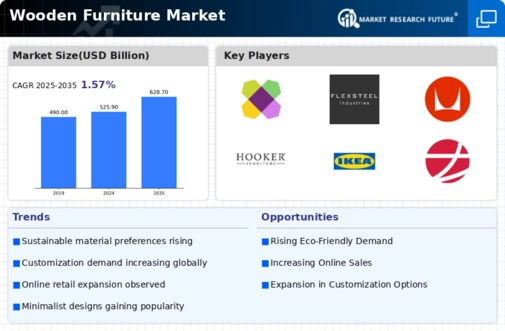The Wooden Furniture Market is currently characterized by a dynamic competitive landscape, driven by factors such as sustainability, digital transformation, and evolving consumer preferences. Major players like IKEA (SE), Ashley Furniture Industries (US), and Steelcase (US) are strategically positioning themselves to leverage these trends. IKEA (SE) continues to innovate with its sustainable product lines, focusing on eco-friendly materials and circular economy principles. Ashley Furniture Industries (US) emphasizes regional expansion and customization, catering to local tastes while maintaining a robust supply chain. Steelcase (US) is heavily investing in digital solutions to enhance customer experience and operational efficiency, indicating a shift towards technology-driven strategies. Collectively, these strategies not only enhance their market presence but also shape a competitive environment that increasingly values sustainability and innovation.
Key business tactics within the Wooden Furniture Market include localizing manufacturing and optimizing supply chains to respond swiftly to market demands. The market structure appears moderately fragmented, with a mix of large multinational corporations and smaller, niche players. This fragmentation allows for diverse offerings but also intensifies competition among key players, as they strive to differentiate themselves through unique value propositions and operational efficiencies.
In August 2025, IKEA (SE) announced the launch of a new line of modular furniture designed for urban living, which reflects a growing trend towards space-saving solutions. This strategic move not only caters to the increasing demand for multifunctional furniture but also reinforces IKEA's commitment to sustainability by utilizing recycled materials. The introduction of this line is likely to enhance IKEA's competitive edge in urban markets, where space constraints are a significant concern.
In September 2025, Ashley Furniture Industries (US) unveiled a partnership with a technology firm to develop an augmented reality (AR) application that allows customers to visualize furniture in their homes before purchase. This innovative approach is expected to enhance customer engagement and streamline the buying process, potentially increasing conversion rates. By integrating AR technology, Ashley Furniture is positioning itself as a forward-thinking player in the market, likely attracting tech-savvy consumers.
In October 2025, Steelcase (US) launched a new initiative focused on sustainable office furniture solutions, aiming to reduce carbon footprints across its product lines. This initiative aligns with the growing emphasis on corporate responsibility and sustainability in the workplace. By prioritizing eco-friendly practices, Steelcase not only meets regulatory expectations but also appeals to environmentally conscious businesses, thereby enhancing its market position.
As of October 2025, current competitive trends in the Wooden Furniture Market are increasingly defined by digitalization, sustainability, and the integration of artificial intelligence. Strategic alliances among companies are shaping the landscape, fostering innovation and enhancing supply chain reliability. Looking ahead, it appears that competitive differentiation will evolve from traditional price-based competition to a focus on innovation, technology integration, and sustainable practices, reflecting a broader shift in consumer expectations and market dynamics.


















Leave a Comment